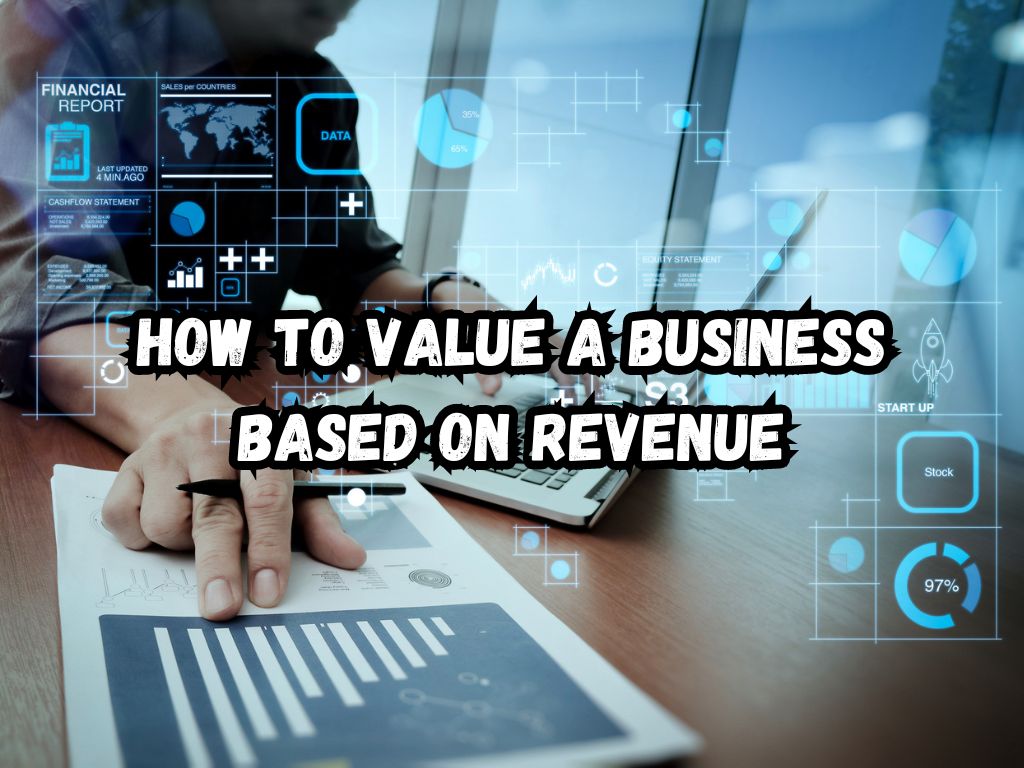When it comes to determining the value of a business, the stakes are undeniably high. Venturing into the complex realm of business valuation, one rapidly encounters an array of methods, each suited to different business types and industries.
Among these, the revenue-based valuation stands out for its direct approach and prominent application across various sectors. So, how to value a business based on revenue? Let’s learn.
Understanding Revenue-Based Business Valuation
The essence of revenue-based valuation is found in its simplicity: it assesses a company’s worth based on its sales.
Unlike profit-oriented metrics that can be influenced by tax strategies and accounting practices, revenue is a relatively straightforward figure that reflects the company’s market position and capacity to generate cash flow.
While earnings-based valuations factor in profitability and asset-based valuations focus on the company’s tangible assets, revenue-based valuations operate on the principle that current and future sales provide a transparent prism through which the business can be appraised.
Preparing for Valuation
To embark on a revenue-based valuation, one needs to first assemble all necessary financial records. Accurate and up-to-date income statements are essential to capture a clear picture of your sales figures.
Ensuring that these financial documents are in order not only aids in a smoother valuation process but also instills greater confidence in potential buyers or investors.

How to Value a Business Based on Revenue
Valuing a business based on its revenue is an intricate process with several critical steps. Initial stage involves calculating annual revenue, which sets the foundation.
This figure is then tempered with industry-specific multipliers, which are coefficients that reflect how much investors are willing to pay per dollar of revenue.
Selecting the right multiplier is more art than science and requires a clear understanding of prevailing market conditions and business peculiarities.
Adjustments no doubt come into play. Various market variables can inflate or deflate the chosen multiplier.
Economic fluctuations, consumer trends, potential for expansion, competitive landscape, and the company’s own historical growth rates all weave into this final adjustment.
Common Revenue Multiples by Industry
Average revenue multiples can vary significantly by industry. For instance, tech startups might be valued at 10 times revenue due to high growth expectations, whereas the retail industry might see multiples of only 0.5 to 2 times revenue because of lower growth rates.
It’s crucial to remember that these are merely benchmarks. The specifics of any individual company can lead to substantial deviations from the average.
A company’s unique attributes—such as its brand strength, customer base characteristics, and intellectual property—can all sway potential multipliers.
Enhancing the Accuracy of Your Valuation
To enhance the accuracy of a revenue-based valuation, it’s important to navigate common pitfalls.
Overestimating the multiplier or neglecting the quality of revenue—factors like customer concentration risk and the rate at which new customers are acquired—can skew the valuation significantly.
It is often prudent to seek third-party validation to avoid bias and ensure a credible and defendable valuation.
Revenue-Based Valuation in Practice
As we consider real-world applications, revenue-based valuations shine the brightest in high-growth environments where future sales are anticipated to expand rapidly.
They are less suited to industries with thin margins or those heavily reliant on physical assets. Take, for example, a software as a service (SaaS) company that relies on renewable customer subscriptions, which can be a lucrative and predictable revenue source.
A valuation grounded in revenue may be more reflective of this business’s potential than a traditional earnings-based model.
Leveraging Revenue-Based Valuation for Strategic Decisions
Understanding a company’s valuation is not just a snapshot of its financial worth; it becomes a powerful tool for making strategic decisions and planning for the future.
By examining five key areas where insights from a revenue-based valuation can be crucial, business owners and executive teams can align their strategies to optimize growth and seize opportunities effectively.
Growth and Expansion Plans
Evaluate Scalability: A firm grasp of your valuation can help determine whether it’s the right time to invest in growth.
If the valuation shows a strong upward trajectory, it might be an opportunity to push for expansion while the company has market momentum.
Tailored Expansion Strategies: Expansion initiatives can be shaped around the company’s strong points that contribute to its valuation. For instance, if recurring revenue streams greatly contribute to valuation, strategies could focus on replicating and expanding these models in new markets.
Risk Assessment: Valuation insights can guide how aggressively a company pursues growth. Understanding how the market values different aspects of a business can help in gauging the associated risks with expansion.
Data-Driven Decision Making: Use historical valuation data as benchmarks for setting realistic growth goals.
Balanced Investment: Invest in resources proportional to their impact on revenue and valuation. Don’t overextend into areas that do not significantly contribute to the valuation.
Pricing Strategies
Value Proposition: Pricing strategies should reflect the value customers perceive, which in turn influences revenue and valuation.
The right pricing can improve both profitability and market position, thus enhancing valuation.
Adjustment Implications: A change in pricing affects not only sales volume but also market perception of the company’s worth.
An optimal pricing strategy is one where the price points are justified by the value delivered, contributing positively to the revenue and valuation.
Market Penetration vs. Premium Pricing: Use valuation insights to decide if the company should adopt a market penetration strategy (lower prices, higher volume) or a premium pricing strategy (higher prices, lower volume but greater margins), both of which can advance the company’s market share and valuation in different ways.

Merger and Acquisition Opportunities
Strength Indication: A strong valuation can give companies leverage during M&A negotiations. It showcases financial health and market position, which can be persuasive for both buyers and sellers.
Bargaining Power: Sellers can command a premium price, or buyers can justify their offer based on their strong valuation position. Knowledge of valuation multiples and industry norms can help in these discussions.
Terms of Merger or Acquisition: Use valuation to outline favorable terms in the case of cash versus stock transactions and earn-outs dependent on future performance, which might be suggested by revenue trends.
Investment in Research & Development (R&D)
Sustainable Growth: R&D investment can lead to new products and services that have the potential to increase revenue streams, diversify offerings, and ultimately enhance valuation.
Market Perception: Proactive investment in R&D is often viewed positively by the market and can increase the company’s valuation as it underscores the company’s commitment to innovation and staying ahead of competitors.
Long-Term View: Align R&D spending with clear long-term growth objectives that are informed by valuation insights. Invest in areas with the potential to create new revenue streams that will increase future valuations.
Attracting Investment
Investor Confidence: A solid revenue-based valuation demonstrates to investors that the business has a strong market position and potential for growth, which can help raise capital for expansion.
Valuation as a Marketing Tool: Use your revenue-based valuation in investment presentations to highlight past growth and projected future success.
Transparency: Clearly communicate how the valuation was determined and the strategies in place to enhance future valuations, which can increase trust and attract investment.
Highlighting KPIs: Focus on key performance indicators that investors care about, such as customer acquisition cost, lifetime value, and retention rates, which all contribute to the revenue-based valuation.
Integrating insights from a revenue-based valuation into strategic decision-making is a multifaceted process that touches on every aspect of the business, from growth plans and pricing strategies to mergers and innovation investments.
Not only does a robust valuation provide a clear picture of current worth, but it also offers a forward-looking lens through which to consider potential investments, partnerships, and market opportunities.
By making data-driven decisions aligned with valuation insights, a business can position itself for sustainable growth and success.
The challenge for business owners and executive teams is to keep the balance between short-term performance and the long-term vision that will drive the company’s value.
An astute understanding of how various strategic initiatives and market dynamics influence valuation is critical for creating a roadmap that drives value creation and positions a company favorably in the eyes of stakeholders and the wider market.
After the Valuation – Next Steps
The journey doesn’t end with valuation. A company’s worth is not static and should be re-evaluated periodically to factor in new market conditions, competition, and internal growth.
Moreover, understanding the valuation’s implications is just as vital. It can inform strategy for a future sale, fundraising rounds, or simply guide internal decision-making.
In sum, a revenue-based valuation offers a lens that brings certain aspects of a company’s health into focus.
It shines in scenarios where future growth prospects dwarf current profitability, but it should be approached with an understanding of its nuances and limitations.
For many businesses, the objectivity and expert perspective of a professional valuator can prove invaluable.
Whether you’re planning for the future, considering an investment, or readying your business for sale, delving into a proper valuation is not just beneficial—it’s essential.


 Tags:
Tags:










